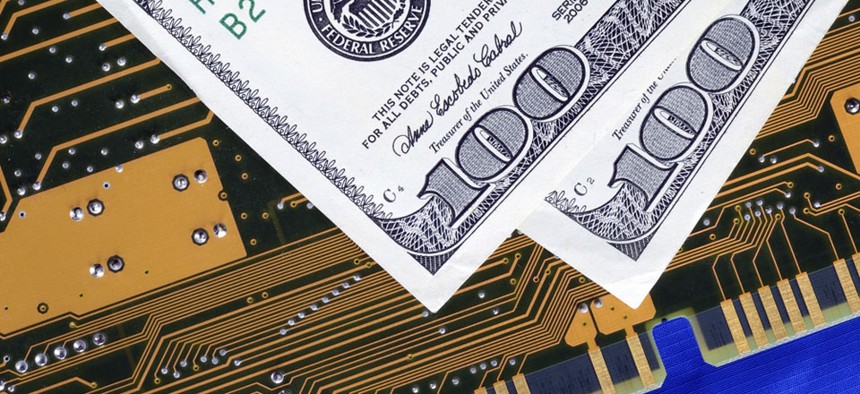For the Federal IT Budget, Things May Finally Be Looking Up

JohnKwan/Shutterstock.com
Overall, the total federal IT budget proposed by the president would tick up to $86 billion, a 2.7 percent increase above the current year’s levels.
After years of pared-down IT spending across government -- and despite the threat of a return to automatic across-the-board cuts in 2016 -- things may finally be looking up.
Overall, the total federal IT budget envisioned by President Barack Obama in his fiscal 2016 budget blueprint released last week would tick up to $86 billion, a 2.7 percent increase above the current year’s levels.
"When it comes to IT, the tone of this budget seems to be recovery, in terms of giving agencies more money to kind of take things off the shelf that they've had to put off over the past couple of years,” said Deniece Peterson, director of federal industry analysis with market research firm Deltek, during a webinar Tuesday.
In fact, depending on how you slice it, the growth in federal IT spending could reach as high as 4 percent, according to Deltek’s analysis, which excludes spending on grants to state and local governments.
“It seems to be a fairly optimistic budget to allow agencies to catch up and help close that technology gap that the administration and the Department of Defense talk about fairly frequently,” Peterson added.
About half the proposed IT spending for 2016 is set aside for civilian agencies. DOD, meanwhile, is budgeted about $37.3 billion for IT.
Biggest Winners: IRS, DHS and VA
The biggest percentage increases on the civilian side are slated for three key areas: updating and modernizing computer systems at the Internal Revenue Service, cybersecurity efforts at the Department of Homeland Security, and expanding the Department of Veterans Affairs’ online benefits programs.
The administration is requesting an 18 percent increase for the IRS’ cornerstone tax-processing modernization project, according to the Deltek analysis. The Customer Account Data Engine -- known as CADE 2 -- aims to update the way the agency processes tax returns, a system that currently relies on equipment dating to the Kennedy administration.
Spending on services for IRS mainframes and servers is set to grow by $219 million -- a 41 percent jump. Last summer, IRS Commissioner John Koskinen likened the agency's jury-rigged and patched-over IT infrastructure to a "Model T.”
At DHS, planned spending increases revolve around security and access management, according to Deltek’s analysis of the 2016 budget request.
Funding for the agency’s National Protection and Programs Directorate is slated to grow by $88 million -- a 23 percent increase.
The administration is planning another huge increase -- an additional $85 million -- in spending for U.S. Customs and Border Protection’s “Nonintrusive Inspection Systems.” That’s a 70 percent jump above current-year levels. The systems allow CBP to inspect and screen cars, trucks, railcars -- even personal luggage and mail -- that crosses U.S. borders using either X-ray or gamma-ray technology.
Obama’s budget overall proposed $14 billion to fund governmentwide cybersecurity efforts, including an expansion of DHS’ continuous diagnostics and monitoring program. However, not all cyber funding is allocated to DHS.
Finally, the administration has requested a 5 percent increase to VA’s IT budget, primarily to improve the agency’s benefits processing and the digital services it offers veterans.
The department’s effort to move toward paperless delivery of VA benefits is due for a major increase, from $44 million currently to $259 million -- an 81 percent increase.
VA’s massive effort to revamp its digital service delivery, the "One Vet" program, would see a 65 percent increase, while a plan to redesign its enrollment system would grow from $6 million to $49 million, a whopping 700 percent spike.
Labor Plans to Spend Big on Digital Project
Overall, spending on IT operations and maintenance -- legacy spending -- continues to dominate the IT budget, according to Deltek’s analysis.
In fact, the budget request actually shows a 1 percent drop in funding for new programs -- from 22 percent of total proposed spending last year to 21 percent.
Still, some agencies would buck that trend. The Labor Department’s 2016 budget request would nearly double funding for new projects -- the largest increase among civilian agencies -- fueled by plans for its integrated digital government platform.
That program is a cloud-based series of services that will allow agency employees to collaborate via video teleconferencing, boost mobile workforce capabilities (including a choice of three different mobile providers: BlackBerry, Apple or Samsung) and expand the agency’s array of digital assets.
The 2016 budget proposes tripling funding for that program -- from $30 million to about $120 million.
Agency IT Spending on Track To Exceed Requests
Still, it’s important to note the White House budget is only a request and merely the opening round of budget negotiations soon to consume Capitol Hill. An added wrinkle is the scheduled return of the automatic sequestration cuts. A two-year agreement blunting the impact of cuts for 2014 and 2015 expires at the end of September unless Congress acts.
"The good thing about that is that IT is such a small part that overarching discretionary number that it's possible that some of the increases could stand," Peterson said.
In fact, if you compare what agencies requested for this year compared to the estimates of actual spending, "most agencies are actually reporting an increase over the request -- so they're getting more than they requested compared to last year," Peterson said.
You have to go back to 2010 to see a similar trend. That was the last year agencies' actual IT spending exceed the request, Peterson explained.
This year and next are shaping up to be a return “to that kind of old-school paradigm of getting more than you asked for,” Peterson added. “However, that 'more' is not as much as it used to be ... and there's definitely going to be more scrutiny on how those dollars are spent."
(Image via JohnKwan/Shutterstock.com)





